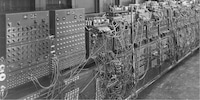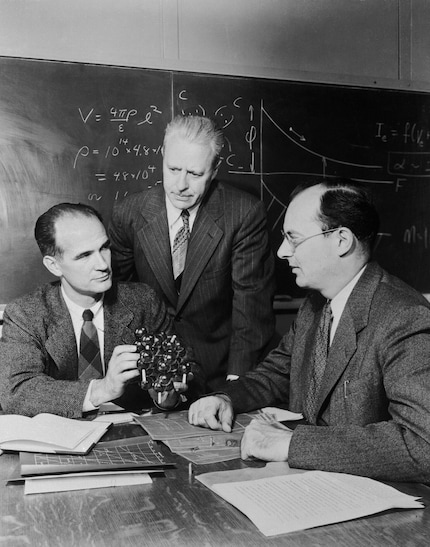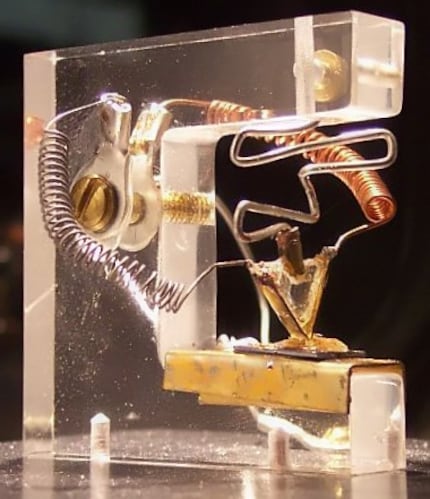
Background information
Now it's going digital: History of computing, part 3
by Kevin Hofer

Semiconductors are an integral part of computers. They are what move your digital devices. In the fourth part of the history of computing, you will learn more about the importance of transistors.
Yes, I know, in the last part I promised to write about mainframes, operating systems and programming languages. But user Speznaz wanted to read a bit more about transistors. As there is so much to write about, I decided without further ado to dedicate a separate part to transistors.
The transistor was developed between 1947 and 1948 by the American physicists John Bardeen, Walter H. Brattain and William B. Shockley. Transistors replaced electron tubes as bit carriers in the 1950s. Transistors are small, generate little heat, require little power and are very reliable. They made small, complex circuits possible in the first place.
Transistor is a portmanteau word and is formed from the two English terms transfer and resistor. The name therefore already indicates the basic function of the transistor. But more on that later. The name was coined by Bell Labs employees and science fiction author John Robinson Pierce in May 1948. The discoverers of the transistor effect, Bardeen, Brattain and Shockley, were honoured with the Nobel Prize in Physics in 1956 for their discovery.
Electron tubes are large, fragile, consume a lot of power and their lifespan is relatively short. Electromechanical switches or relays are slow and unreliable because they often get stuck in the on or off position. In systems with thousands of tubes, they therefore quickly reach their limits and need to be constantly monitored to prevent failures.
Computer developers were confronted with these problems in the 1940s. Semiconductors therefore offered themselves as an alternative. The electrical conductivity of silicon and germanium lies between that of non-conductors such as glass and conductors such as aluminium. Researchers discovered as early as the beginning of the 20th century that the conductive properties of semiconductors can be manipulated by adding impurities.
As is so often the case, it was military research that helped the development of the transistor to achieve a breakthrough. In this case, it was radar research. Superheterodyne receivers are used to receive radio waves. They require rectified diodes that operate at ultra-high frequencies above one gigahertz. Electron tubes cannot do this.
In 1925, Julius Edgar Lilienfeld described an electronic component that had the properties of an electron tube. The management of Bell Laboratories in the 1930s - the former research department of the telephone company AT&T - recognised the possibilities of semiconductors. They were to replace electron tubes and electromechanical switches in the Bell telephone system.
The first attempts to manufacture transistors during the Second World War by William B. Shockley failed. After the Second World War, the research department at Bell Laboratories was restructured and a research group was set up under the direction of Shockley.
Shockley argued that the electric field of a third electrode underneath the semiconductor layer would increase its conductivity. This should allow sufficient current to flow through the layer. However, initial attempts failed again. It was John Bardeen, a member of the research group, who pointed out that electrons drawn to the semiconductor layer by the electric field prevented it from penetrating.
Shockley and Bardeen used this realisation to develop the peak transistor towards the end of 1947. This worked in a similar way to the semiconductors in the superheterodyne receiver. When a voltage is applied to the base, the current begins to flow via the collector to the emitter. The first functioning transistor was invented.
If you would like to find out more about how these so-called bipolar transistors work, I can recommend the article in the Electronics Compendium.
In the following years, transistors were continuously developed further. The first commercially manufactured transistors were sold as early as the 1950s. Initially, they were mainly used in hearing aids and portable radios. Over time, they were also used as a replacement for electron tubes in computers. By the end of the 1950s, transistors had almost completely replaced electron tubes in computers.
The first transistors were made of germanium. This material has a significant disadvantage. Relatively little voltage is required to move electrons through the transistor. This is also temperature-dependent. If germanium transistors are not supposed to conduct, electrons may still flow if the temperature is high. They are therefore less suitable for circuits in warmer areas.
This is where silicon comes into play. Due to its higher melting temperature, it is more suitable for circuits in warmer areas. Texas Instruments also recognised this and began selling transistors made of silicon in 1954.
If you want to find out more about how MOS field-effect transistors work, I also recommend the article in the Electronics Compendium.
That's it for this detour into the world of transistors. Next time, you'll really read more about mainframe computers, operating systems and programming languages.
From big data to big brother, Cyborgs to Sci-Fi. All aspects of technology and society fascinate me.
Practical solutions for everyday problems with technology, household hacks and much more.
Show all
Rectifiers with a silicon or germanium layer stepped into the breach. Two tungsten leads are inserted into these semiconductor materials, which in turn are equipped with impurities such as boron or phosphorus. These displace silicon or germanium atoms and generate carriers such as electrons. Depending on the type of charge carrier or the voltage generated, current can flow into the silicon or germanium layer via one cable and flow out via the other. This also works the other way round, but never in both directions. The superheterodyne receivers equipped with such rectifiers were able to operate in the gigahertz range. This allowed microwave radiation to be detected by military radar systems.

Another important development for computers were MOS field-effect transistors, more precisely CMOS. These were developed by Francs Wanlass in 1963. They are particularly suitable for integrated circuits because they are easy to manufacture. Towards the end of the 1960s, MOS field-effect transistors began to replace bipolar transistors in the manufacture of microchips. They have been standard in digital applications since the 1980s. Bipolar transistors are mainly used in analogue devices.